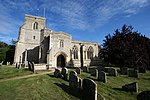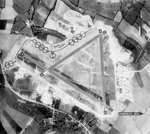Wells Farm
Berkshire, Buckinghamshire and Oxfordshire Wildlife Trust

Wells Farm is a 64-hectare (160-acre) nature reserve on the eastern outskirts of Little Milton in Oxfordshire. It is managed by the Berkshire, Buckinghamshire and Oxfordshire Wildlife Trust.This is a working farm which grows wheat and barley. The fields have six metre wide margins which have been sown with wildflower seeds. There are also areas of wetland, grassland and woods. Birds include yellowhammer, grey partridge and red kite.There is a footpath through the farm.
Excerpt from the Wikipedia article Wells Farm (License: CC BY-SA 3.0, Authors, Images).Wells Farm
Chiltern View, South Oxfordshire
Geographical coordinates (GPS) Address Website Nearby Places Show on map
Geographical coordinates (GPS)
| Latitude | Longitude |
|---|---|
| N 51.7053 ° | E -1.09766 ° |
Address
Wells Farm
Chiltern View
OX44 7QP South Oxfordshire
England, United Kingdom
Open on Google Maps









